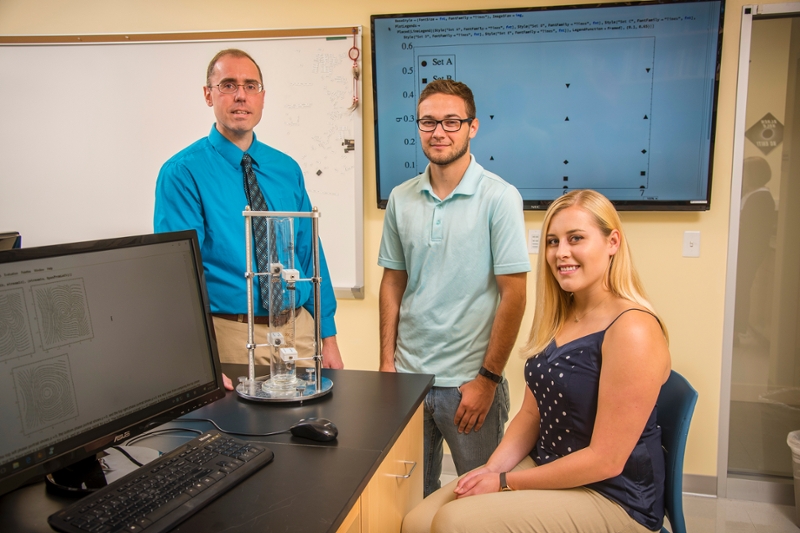
Download Image: Web
Lycoming College physics majors Brianna Zawadzki ’18 and Tom Osborne ’18, and Christopher Kulp, Ph.D., professor of physics and chair of the department of astronomy and physics at Lycoming College, co-authored a paper published in prominent academic journal The Physical Review E, in August. Their paper, “Using missing ordinal patterns to detect nonlinearity in time series data,” explains a new way to determine the type of equations, linear or nonlinear, needed to model a system by analyzing data measured from the system. Understanding the type of equations that govern a system’s behavior is an important first step in building predictive mathematical models of that system. While the paper looked specifically at data measured from a laser, sunspot data and electroencephalogram data, the technique can work on a wide variety of different types of systems from fields as diverse as physics, biology, engineering and even finance.
Born out of a larger research project that Kulp is working on with collaborator and paper co-author Luciano Zunino, Ph.D., a researcher at the National Scientific and Technical Research Council in Buenos Aires, Argentina, Kulp saw an opportunity for undergraduates to contribute, as well as strengthen their own research skills. Zawadzki and Osborne analyzed EEG data from people in various stages of a seizure. They had to apply the new methodology to a half-million data sets, and in doing so, were able to detect nonlinear behavior in the EEGs of people experiencing a seizure and found that behavior was not occurring in people not experiencing a seizure.
Zawadzki and Osborne, as well as several other physics majors from Lycoming, are part of Kulp’s research group, comprised of select students who want to learn to do scientific research as undergraduates. The students assist Kulp with his professional projects, and while they don’t receive payment or academic credit for their work, they do learn how to work as part of a research team, including how to collaborate with others. In addition, they learn problem solving and critical thinking skills that prepare them for graduate school and the workforce. Kulp believes opportunities such as this make Lycoming unique. “Our students are working directly with a Ph.D. faculty member in the field — not a graduate assistant or post-doc. I try to give them a sense of what it’s like to be in graduate school. We discuss our projects, ask questions and present our work to each other during regular meetings of the research group,” said Kulp.
“I believe it is very important to include undergraduates in my research. I was involved in research as an undergraduate, and I greatly benefitted from it. It gave me a window into how physics works at the professional level,” Kulp added. “It’s the same reason I have the group — to give students experiences that help them develop as physicists.”
“I'm incredibly thankful that Dr. Kulp invited Tom and me to work on this project with him. I never expected to have my name on a published paper as an undergraduate, and I definitely think this will help make me a more competitive applicant to grad schools,” said Zawadzki. “The experience of working on this project — and being in Dr. Kulp's research group in general — really helped prepare me for my research experience at Harvard last summer. Even though the research topics were completely different, it allowed me to get a feel for what a real research environment is like.”
“Dr. Kulp has been an excellent advisor. I was honored that he asked me to be a part of his research group and I have gained valuable experiences while working under him,” said Osborne. “I am currently interning as a software engineer and I plan to either get a full time job doing the same type of work, or pursuing a computer science program in grad school. Adding this publication to my resume will make me more attractive to potential employers and graduate schools, so I am very thankful that Dr. Kulp allowed me to be a part of this.”
The paper can be found at: https://journals.aps.org/pre/abstract/10.1103/PhysRevE.96.022218.